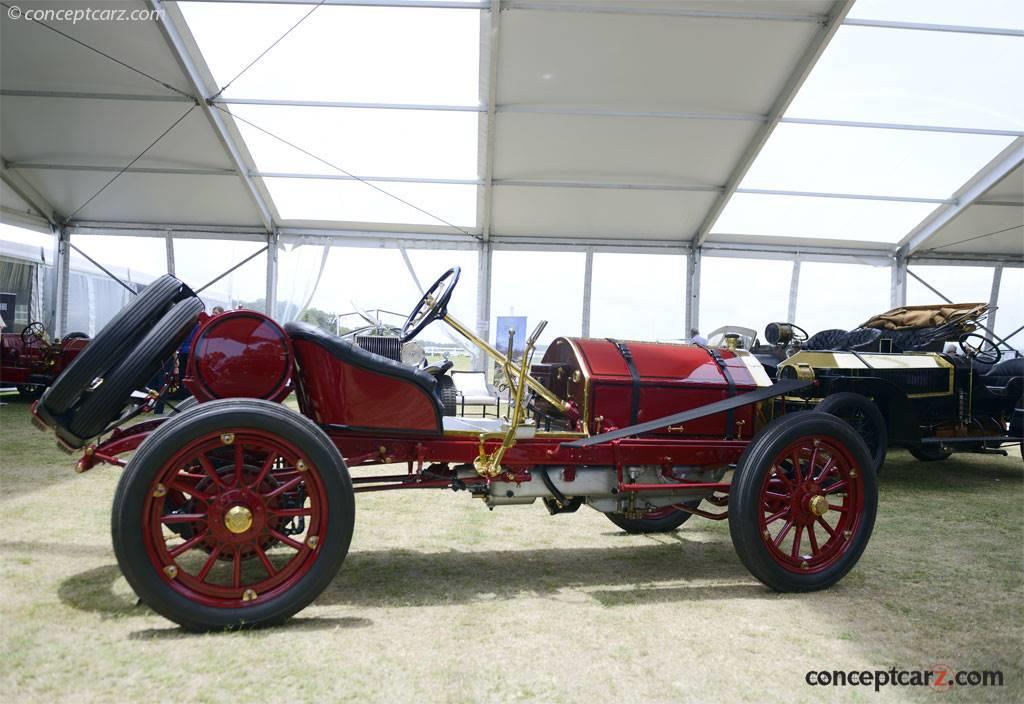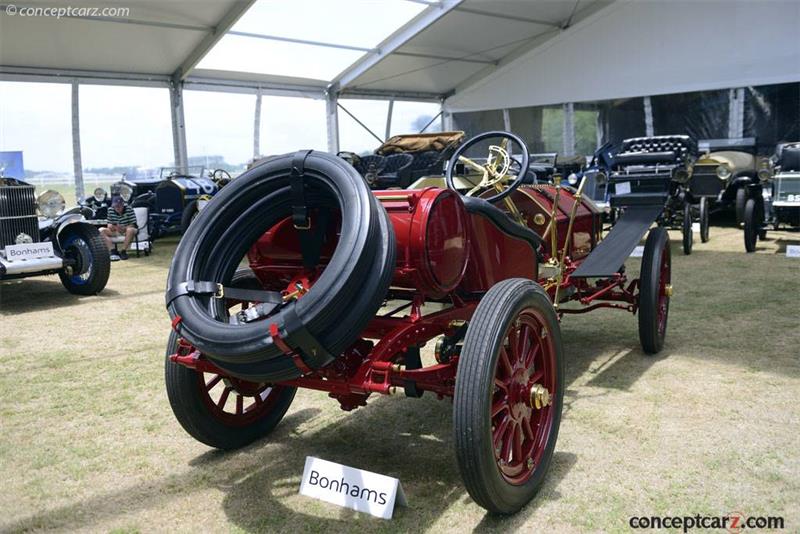During the birth of the automobile, the typical motorcar resembled carriages that had lost their horses. The Springfield, Massachusetts-built Knox, however, was entirely different, with the three-wheeled vehicle employing tiller steering and wearing a sulky-like body. The propulsion system was also of a unique design, with the single-cylinder engine being air-cooled by means of steel pins, screwed into the sides of the cylinder walls. This design expanded the cooling surface of the engine and allowed it to be cooled by the air flowing over its surface. This made the Knox one of the earliest air-cooled American automobiles and its design earned it the nickname, the 'Porcupine.' Air-cooling remained a Knox feature well into the decade, but the three-wheeled design lasted briefly, only through 1901. 
Touring
Engine #: 2R9
View info and history
Auction entries : 1The early Knox vehicles were built in surprisingly large numbers for a gasoline-powered car in this era, attributed partly to their excellent engineering, reliability, and ease of operation. A tapered camshaft adjusted the intake valve and the vehicle's throttle, and a small Knox-designed spray jet carburetor fed the long intake manifold. The startup operation was a rather simple affair thanks to the total loss, coil ignition that was powered by a dry cell. Mr. Harry Knox was a resident of Springfield, Massachusetts, and was the neighbor of J. Frank Duryea. Mr. Duryea encouraged his neighbor to enter automobile production, who had experience with motorcars while working at the Overman Wheel Company, where they developed several experimental automobiles. Mr. Knox had the experience and lived in a city known for its sophisticated manufacturing. Springfield was later chosen by Rolls-Royce as the location for their American-built motorcars. It is believed that Mr. Knox built sixteen examples of the three-wheeled motor cars in 1899, followed by approximately 100 examples in 1900. The three-wheeled vehicles served as the foundation for the burgeoning company, beautifully conceived and elegantly styled, and both sophisticated and simple. Throughout the years, the designs would evolve into fine luxury vehicles, which by 1909 used modern shaft drive and water-cooled four-cylinder engines, with overhead valves operating both intake and exhaust. The well-engineered aluminum gearbox used an unusually smooth oil-bathed clutch with three forward speeds. 
Touring
Engine #: 2R9
View info and history
Auction entries : 1Production steadily increased as the years ticked by, with approximately 250 examples in 1902, doubling to 500 in 1903, and by 1906, that number had risen to 753 units. Around 1,00 examples were built a year later, followed by 1,215 in 1908 and 1,317 in 1909. The peak of production was in 1910, with 1,412 units built before falling slightly to 1,215 the following year, and then to 877 in 1912. During its last two years of automobile production, the company built 673 units in 1913 and 383 in its final year. The company's demise is attributed to several factors, most notably the rise in competition throughout the industry and the loss of its 'Porcupine' identity as the company moved to water-cooled engines from 1910 forward. A six-cylinder model joined the lineup in 1911 - a strategic move that mimicked the direction of many other automobile makers but one that further separated from its unique past. As 1912 was coming to a close, the company began operating under trusteeship after the death of the company's treasurer A.N. Mayo. By 1914, the company's assets were acquired by Edward O. Sutton, who reorganized it as the Knox Motors Company. Passenger car production soon came to a close as the company focused on its tractor-trailer and fire apparatus. In 1919, the company merged with Militor Corporation of Springfield.The 1909 and 1910 Knox model lineup included an air-cooled Model H equipped with a four-cylinder engine delivering 30 horsepower and its five-passenger touring body resting on a 102-inch wheelbase platform. The Model O also used a 102-inch wheelbase, but its four-cylinder engine was water-cooled and delivered nearly 40 horsepower. The Model O could also be purchased with a 114-inch wheelbase platform which was used for larger coachwork, including a five-passenger limousine and landaulet. The Model M was the largest vehicle in Knox's arsenal, with a 127-inch wheelbase and a 48-horsepower, water-cooled, four-cylinder engine. 
Touring
Engine #: 2R9
View info and history
Auction entries : 1The Model R used a 117-inch wheelbase, the Model M had a 127-inch platform, and the Model S had a 134-inch wheelbase. The Model S was a six-cylinder model with 60 horsepower and prices that typically eclipsed $5,000. Prices on the Model R ranged from $3,150 to $4,000. Most of the Knox vehicles could be acquired with touring coachwork or as a Raceabout, with just a seat and a gas tank. When this minimalistic coachwork was applied to the Model R, it was capable of 70 mph, making them perfectly suited for many of the race tracks around the country.
by Daniel Vaughan | Jul 2021

Touring
Engine #: 2R9
View info and history
Auction entries : 1

Touring
Engine #: 2R9
View info and history
Auction entries : 1

Touring
Engine #: 2R9
View info and history
Auction entries : 1
by Daniel Vaughan | Jul 2021
Knox
Similarly Priced Vehicles
White Model O ($4,000-$5,000)
American Underslung ($3,750-$4,000)
Pierce-Arrow Model 36 ($3,700-$4,700)
Packard Model 18 ($2,950-$4,350)
Winton Model 17 ($3,000-$4,650)
Franklin Model D ($2,700-$4,000)
Knox Model O ($2,950-$3,750)
Locomobile Model 30 ($3,500-$3,500)
Pope-Hartford Model S ($2,750-$3,750)
Lozier Model J ($3,500-$4,200)
Average Auction Sale: $142,800
American Underslung ($3,750-$4,000)
Pierce-Arrow Model 36 ($3,700-$4,700)
Packard Model 18 ($2,950-$4,350)
Winton Model 17 ($3,000-$4,650)
Franklin Model D ($2,700-$4,000)
Knox Model O ($2,950-$3,750)
Locomobile Model 30 ($3,500-$3,500)
Pope-Hartford Model S ($2,750-$3,750)
Lozier Model J ($3,500-$4,200)
Average Auction Sale: $142,800
1909 Knox Model R Vehicle Profiles
Recent Vehicle Additions
Performance and Specification Comparison
Price Comparison
$2,950 - $3,750
Related Automotive News

Best in Show at The Greenbrier Concours d'Elegance
The fifth annual edition of The Greenbrier Concours dElegance at Americas Resort, The Greenbrier, attracted a curated list of nearly one-hundred exquisite vehicles to the luxury mountain resort located in the Allegheny Mountains in White Sulphur...

RM Auctions to Present The Merrick Auto Museum Collection at 13th Annual Hershey Sale
OVER 100 BRASS ERA CARS AND SELECTION OF MEMORABILIA OFFERED ENTIRELY WITHOUT RESERVE
RM Auctions set to offer the Merrick Auto Museum Collection at Hershey auction, 10-11 October in Pennsylvania
Offered entirely without reserve, the multi...

Premier To Make Its Premiere
Pioneering Indianapolis motor manufacturer makes its first ever appearance on Veteran Car Run
Roll out the red carpet this years Bonhams London to Brighton Veteran Car Run supported by Hiscox will feature another premiere… and, appropriately, this...












